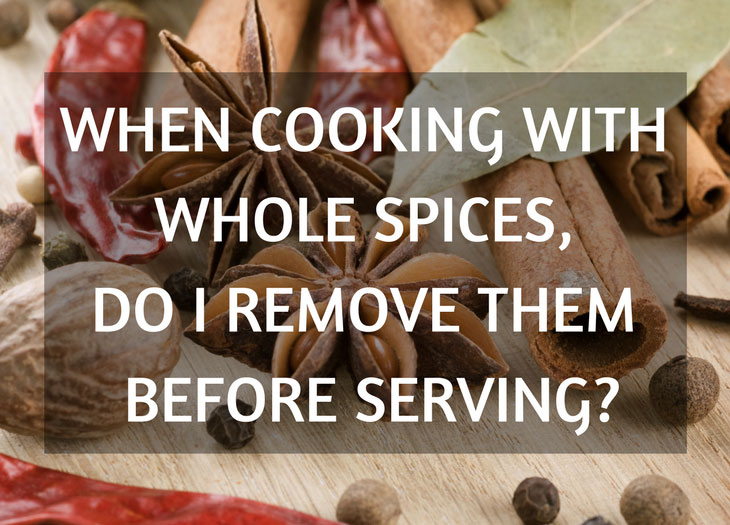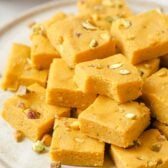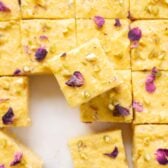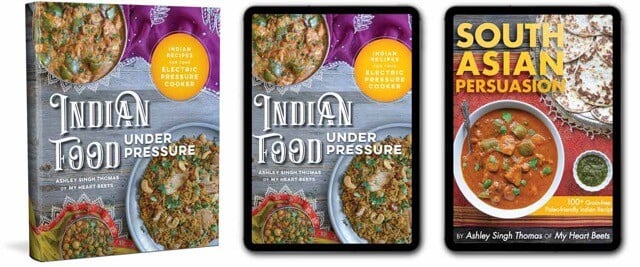When cooking with whole spices, are you supposed to remove them before serving?

So you’ve finished cooking an Indian dish, and it’s delicious! Maybe it was my chicken biryani? Or perhaps one of my curry recipes on the blog? Now that you’re done cooking, you might be wondering – what do I do with the whole spices floating around/hiding in the dish?
If you’re asking yourself that question, know that you are not alone. This is one of the things that I get asked about ALL. THE. TIME.
And after answering this question in text messages, via email, in blog comments, and on social media, I’ve decided that it’s finally time to write a blog post about this because clearly, this is a question that needs answers.
How do you discard whole spices? The short answer is that you have a few options:
If you don’t want to read this whole post, here’s the short answer: move the spices to the side of your plate as you eat (give those eating a heads up to do the same). Or fish through the dish and remove them yourself (e.g., if you added 5 cardamom pods to the dish, remember to remove the 5 cardamom pods). Another idea is to fry the larger whole spices (cinnamon, clove, cardamom, bay leaf) in oil, remove them with a spoon and place them into either a teabag pouch or a metal tea strainer.
Now, here’s the long answer:
What do I do with my whole spices once I’m done cooking an Indian dish?
Do I leave whole spices in the curry? Do I pick them out? Do I warn my guests?
Most of us who grew up in an Indian household are familiar with whole spices and know to move them to the side of our plate as we eat. I’m sure, at some point, every Indian person has accidentally bitten into a clove or cardamom pod. What do we do when that happens? Either eat it or spit it out. 🤷🏽♀️
It’s like eating an olive with a pit. You obviously don’t eat the pit.
No one gets annoyed about eating olives with pits, right? Think of large whole spices the same way.
Sure, biting into a clove isn’t the tastiest thing and can be kind of off-putting if you’re not used to it, but it comes with the Indian food territory. That’s how you know you’re eating some real deal Indian food – when the chef/cook doesn’t care to remove the whole spices (lol).
We are taught from a young age to look for whole spices as we eat. Honestly, I’m not even sure if it’s something we’re actually taught. I think it’s just something we learn… probably after biting into a clove as a kid. My toddler bit into his first clove a few months ago when he was around 15 months old. He made a face to show me that he wasn’t pleased… I’m sure I did the same thing as a kid.
Which whole spices are you not supposed to eat? Which ones are you supposed to eat?
You can, of course, search for whole spices as you eat – some of them are really easy to spot, like cinnamon sticks, star anise, or bay leaves. The trickier whole spices to find are cardamom pods and cloves. And what about curry leaves? Some people eat them, and some don’t. I personally don’t unless the leaves are small.
Then there are the whole spices that you’re supposed to eat – those are the tiny ones like cumin seeds, mustard seeds, and fennel seeds. You can also eat slightly larger ones like coriander seeds and black peppercorns.
That said, what do I do? Personally, when I’m serving Indian food to family, I leave the whole spices in the dish. If I’m having friends over who are not Indian, then I’ll either remove the whole spices myself or give them a heads up – letting them know there might be whole spices in their meal.
I Don’t Like That Answer. I Don’t Want to Bite into Whole Spices. What Else Can I do?
First, I’m going to tell you what NOT to do. Do not substitute whole spices with ground spices to avoid this issue. If a recipe calls for frying whole spices in oil, there’s a reason for it!
There was a good discussion in my facebook group about workarounds to this whole spices issue, and several people suggested using teabag pouches or a metal tea strainer. If you decide to do this, I would first fry the whole spices in oil, then after they have roasted in oil, use a spoon to scoop them into the pouch. This way, they will flavor the oil and then continue to flavor the dish through the pouch.
A simple but effective idea: remember the number of whole spices you use and remove them. If you use 5 whole cardamom pods, then make sure to remove 5 pods at the end. This is a lot easier when you count them out.
I realize that leaving whole spices in a dish is a pretty foreign concept to anyone who isn’t Indian, so I hope this post was helpful! If you have any tips, leave a comment letting us know what you do!
If you did find this helpful, check out the other posts in my Indian Cooking 101 Series!






Cody says
The day someone opens up a shop that sells Indian food with the spices (and bones) removed before serving, he or she will become a millionaire overnight. Two words: “Spice Infuser.” You get all the same flavor without having the sticks and pebbles and leaves and such making the process of actually eating the food so tedious. In my town, about 7 new sit down Indian restaurants and at least 20 new Indian food trucks – no exaggeration – have opened up in the past year. Every single one of them serves similar things, always with the sticks and leaves and pebbles all in there, despite knowing that their audience is going to be primarily Americans who almost universally prefer their food without having to pick things out of it, spit things out, etc. while eating. It seems so strange to me that it has not occurred to so much as even a single ONE of these restaurants that tailoring the serving prep style to suit the customer might be a good idea. I love Indian food, but I really do hate having to pick around at it to be able to eat it.
Harriette says
I’ve mistakenly bit into some whole spices in many different dishes, Indian or otherwise. Some are not so pleasant like whole black pepper or ginger. 😆
David says
this adds amusement to our family meal, cassia bark is easy to find but when someone bites into a cardamom pod (it is not nasty, just strong in flavour) the look on their face and as to whether they carry on or removing it, a test of their strength and determination.
Ashley - My Heart Beets says
This is the best comment hahah. I love this!
Dorothy Waddell says
I also had that question about whole spices and chose to grind them first then real quick fry in oil. You mention not to do this why?
Clo says
Hi Ashley, I just found your blog. So excited to try your Instant Pot Biryani recipe. When using the cardamom pods is it better to cut them open to get more flavor or leave in intact in pod? I’ve always taken the seeds out of the pods it’s rather tedious perhaps it matters on the recipe or I’ve been doing it wrong.
Thank you. Clo
Ashley - My Heart Beets says
Hi Clo, when a recipe calls for whole pods, I would leave them whole and not crush them – the addition of cardamom will add a nice aroma but if you open them it may be more overpowering than what the recipe calls for. I always specify if the pod needs to be crushed (like when making chai for example). Hope that helps!
Caroline says
I don’t know if there’s a solution. I have tried making jeera rice with the spices inside a muslin tea bag and a large metal tea infuser, and even tried covering the spices in the bottom of the rice cooker with a stainless steel flour sieve and cooking the rice inside the sieve. So far, I haven’t found a method that yields satisfactory results, but I’ve seen something on YouTube that I would like to try the next time I make jeera rice: frying the spices in oil, then filtering out the spices and drizzling the oil over cooked rice, and gently mixing the oil and rice together.
Mark says
I always loved the cardamom that was in the rice at a local Indian restaurant. It is a wonderful flavor burst!
My Heart Beets says
Agree! Love whole cardamom pods 🙂
Hector says
My mother always leaves the cardamom in the curry and I nearly die.
My Heart Beets says
Hector, lol! You just have to keep an eye out for it then 😉
ashish patel says
Hey, I read your article and your information are such great and amazing it is so much helpful for me. Thank you so much:)
My Heart Beets says
Glad to hear that!
Misha says
I love Indian food and dont mind leaving the whole spices in however I’ve found a work around by pureeing the curry before adding any veggies or proteins. You may have to adjust the amount of spices. You may sieve or not sieve but it’s fine either way and the spices are very present!
My Heart Beets says
Misha, thanks for sharing!
Shienna says
We call it the lucky bits 😂🤣 Im not indian but when I cook indian dish I leave the spices in the dish.
My Heart Beets says
Haha, love that name!
Tanya says
My husband is Indian and I am not yet I’m the one always telling him whole and ground spices have different flavour and aroma therefore one cannot be substituted for the other. We’ve been trying to find a solution to the whole spice issue when adding tadka as my husband hates crunching into whole spices. Being Punjabi they don’t seem to use large whole spices often so it’s rather new for him when I do it. My solution which is similar to yours is the same technique used for making soups and stews when you want flavour from spices. You just bag it in that tea bag like mesh and tie it up then drop it in and let it infuse. Basically the tea bag solution as you say. This is a topic I’ve been looking to discuss on my blog also so thanks for sharing your experience!
Tanya
Amy Lee says
Oops! Do I have just been substituting ground spices this whole time. Guess that’s a big no no?
My Heart Beets says
No need to change what’s working for ya 🙂 Whole spices just add a different kind of flavor – permeates throughout the oil and adds a lot of aroma too. If you give it a try, tell me what you think 🙂
Claire cornforth says
Thank you for the advice. I have just made a beautiful curry but my husband doesn’t like the seeds etc. Everyone else loved it. What can I possibly do apart from sieve it. I do not want to take away any flavour. Could I puree it up perhaps. Thanks in advance